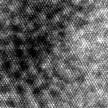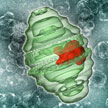Showing Spotlights 97 - 104 of 202 in category All (newest first):
 Friction is present in numerous physical phenomena occurring at all length scale. About 1/3 of the world's primary energy is dissipated in mechanical friction and 80% of machinery components' failure is caused by wear. Friction and wear will also become bottlenecks for micro-/nano-mechanical systems (MEMS and NEMS) featured with sliding components. Superlubricity, a phenomenon where the friction almost vanishes between two solid surfaces, will be the key to solve these problems and researchers now report a breakthrough in macroscale superlubricity.
Friction is present in numerous physical phenomena occurring at all length scale. About 1/3 of the world's primary energy is dissipated in mechanical friction and 80% of machinery components' failure is caused by wear. Friction and wear will also become bottlenecks for micro-/nano-mechanical systems (MEMS and NEMS) featured with sliding components. Superlubricity, a phenomenon where the friction almost vanishes between two solid surfaces, will be the key to solve these problems and researchers now report a breakthrough in macroscale superlubricity.
Nov 7th, 2013
 While nanotechnology combines the knowledge of physics, chemistry and engineering, AI has heavily relied on biological inspiration to develop some of its most effective paradigms such as neural networks or evolutionary algorithms. Bridging the link between current nanosciences and AI can boost research in these disciplines and provide a new generation of information and communication technologies that will have a large impact in our society, probably providing the means so that technology and biology merge
While nanotechnology combines the knowledge of physics, chemistry and engineering, AI has heavily relied on biological inspiration to develop some of its most effective paradigms such as neural networks or evolutionary algorithms. Bridging the link between current nanosciences and AI can boost research in these disciplines and provide a new generation of information and communication technologies that will have a large impact in our society, probably providing the means so that technology and biology merge
Oct 15th, 2013
 Covetics - this new class of materials marks a game-changer for engineers and designers that have long sought to combine high-strength carbon with metal in their pursuit to improve metal's performance. For the first time the hybrid fuses nanocarbons and metal in a bond that is stronger than graphene-like sp2 carbon bonds. To create covetics, its inventors developed a new method of carbon catalyzation which uses molten metal and metal alloys as an ionizing medium. Nanocarbon structures form in situ while bonding to the metal ionizing medium.
Covetics - this new class of materials marks a game-changer for engineers and designers that have long sought to combine high-strength carbon with metal in their pursuit to improve metal's performance. For the first time the hybrid fuses nanocarbons and metal in a bond that is stronger than graphene-like sp2 carbon bonds. To create covetics, its inventors developed a new method of carbon catalyzation which uses molten metal and metal alloys as an ionizing medium. Nanocarbon structures form in situ while bonding to the metal ionizing medium.
Oct 9th, 2013
 It is a challenge to measure the temperature variation at the surface of nanoparticles under optical illumination since nano-localized temperature variation is the most important parameter for applications ranging from nanomedicine to photonics. In particular, the conversion of light to heat trough the exploitation of the Localized Plasmonic Resonance (LPR) has enabled a remarkable breakthrough in fighting cancer. Now, researchers have advanced the monitoring of nanoscale temperature variations under optical illumination by combining the properties of gold nanorods and the capabilities of thermotropic cholesteric liquid crystals.
It is a challenge to measure the temperature variation at the surface of nanoparticles under optical illumination since nano-localized temperature variation is the most important parameter for applications ranging from nanomedicine to photonics. In particular, the conversion of light to heat trough the exploitation of the Localized Plasmonic Resonance (LPR) has enabled a remarkable breakthrough in fighting cancer. Now, researchers have advanced the monitoring of nanoscale temperature variations under optical illumination by combining the properties of gold nanorods and the capabilities of thermotropic cholesteric liquid crystals.
Oct 4th, 2013
 As the use of antibiotics increases for medical, veterinary and agricultural purposes, the increasing emergence of antibiotic-resistant strains of pathogenic bacteria is an unwelcome consequence. The incidence of the multidrug resistance (MDR) of bacteria which cause infections in hospitals/intensive care units is increasing, and finding microorganisms insensitive to more than 10 different antibiotics is not unusual. The emergence of superbugs has made it imperative to search for novel methods, which can combat the microbial resistance. Thus, application of nanotechnology in pharmaceuticals and microbiology is gaining importance to prevent the catastrophic consequences of antibiotic resistance.
As the use of antibiotics increases for medical, veterinary and agricultural purposes, the increasing emergence of antibiotic-resistant strains of pathogenic bacteria is an unwelcome consequence. The incidence of the multidrug resistance (MDR) of bacteria which cause infections in hospitals/intensive care units is increasing, and finding microorganisms insensitive to more than 10 different antibiotics is not unusual. The emergence of superbugs has made it imperative to search for novel methods, which can combat the microbial resistance. Thus, application of nanotechnology in pharmaceuticals and microbiology is gaining importance to prevent the catastrophic consequences of antibiotic resistance.
Sep 10th, 2013
 Vault particles are large, barrel-shaped nanoparticles found in the cytoplasm of all mammalian cells. All human cells so far analyzed have been shown to contain vaults with quantities varying from a few thousand per cell to in excess of 100 000 per cell. As naturally occurring nanoscale capsules, vaults may be useful to engineer as therapeutic delivery vehicles. The particles can be produced in large quantities and are assembled in situ from multiple copies of the single structural protein following expression. Using molecular engineering, recombinant vaults can be functionally modified and targeted, and their contents can be controlled by packaging.
Vault particles are large, barrel-shaped nanoparticles found in the cytoplasm of all mammalian cells. All human cells so far analyzed have been shown to contain vaults with quantities varying from a few thousand per cell to in excess of 100 000 per cell. As naturally occurring nanoscale capsules, vaults may be useful to engineer as therapeutic delivery vehicles. The particles can be produced in large quantities and are assembled in situ from multiple copies of the single structural protein following expression. Using molecular engineering, recombinant vaults can be functionally modified and targeted, and their contents can be controlled by packaging.
Aug 19th, 2013
 For a long time, scientists have been fascinated by the dramatic changes in color used by marine creatures like squids and octopuses, but they never quite understood the mechanism responsible for this. Only recently they found out that a neurotransmitter, acetylcholine, sets in motion a cascade of events that culminate in the addition of phosphate groups to a family of unique proteins called reflectins. Having begun to unravel the natural mechanisms behind these amazing abilities, researchers are trying to use this knowledge to make artificial camouflage coatings. New work addresses the challenge of making something appear and disappear when visualized with standard infrared detection equipment.
For a long time, scientists have been fascinated by the dramatic changes in color used by marine creatures like squids and octopuses, but they never quite understood the mechanism responsible for this. Only recently they found out that a neurotransmitter, acetylcholine, sets in motion a cascade of events that culminate in the addition of phosphate groups to a family of unique proteins called reflectins. Having begun to unravel the natural mechanisms behind these amazing abilities, researchers are trying to use this knowledge to make artificial camouflage coatings. New work addresses the challenge of making something appear and disappear when visualized with standard infrared detection equipment.
Aug 12th, 2013
 Atomically precise manufacturing (APM) can be understood through physics, engineering design principles, proof-of-concept examples, computational modeling, and parallels with familiar technologies. APM is a prospective production technology based on guiding the motion of reactive molecules to build progressively larger components and systems. Bottom-up atomic precision can enable production with unprecedented scope (in terms of product materials, components, systems, and performance), while fundamental mechanical scaling laws can enable unprecedented productivity.
Atomically precise manufacturing (APM) can be understood through physics, engineering design principles, proof-of-concept examples, computational modeling, and parallels with familiar technologies. APM is a prospective production technology based on guiding the motion of reactive molecules to build progressively larger components and systems. Bottom-up atomic precision can enable production with unprecedented scope (in terms of product materials, components, systems, and performance), while fundamental mechanical scaling laws can enable unprecedented productivity.
Jun 11th, 2013
 Friction is present in numerous physical phenomena occurring at all length scale. About 1/3 of the world's primary energy is dissipated in mechanical friction and 80% of machinery components' failure is caused by wear. Friction and wear will also become bottlenecks for micro-/nano-mechanical systems (MEMS and NEMS) featured with sliding components. Superlubricity, a phenomenon where the friction almost vanishes between two solid surfaces, will be the key to solve these problems and researchers now report a breakthrough in macroscale superlubricity.
Friction is present in numerous physical phenomena occurring at all length scale. About 1/3 of the world's primary energy is dissipated in mechanical friction and 80% of machinery components' failure is caused by wear. Friction and wear will also become bottlenecks for micro-/nano-mechanical systems (MEMS and NEMS) featured with sliding components. Superlubricity, a phenomenon where the friction almost vanishes between two solid surfaces, will be the key to solve these problems and researchers now report a breakthrough in macroscale superlubricity. 
 Subscribe to our Nanotechnology Spotlight feed
Subscribe to our Nanotechnology Spotlight feed





